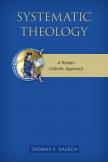Rausch's 'Systematic Theology' promises to be a useful and well-written work on a challenging subject
Every once in a while, a theological text that is useful, balanced, up to date, well written and respectful of tradition appears. This is one of them.
While evidently designed to be a backbone text for upper-level undergraduates or beginning graduate students, this book can profitably be read by educated lay people as well. Rather than constructing a theological system where every chapter is a puzzle piece in an integrated picture, Thomas P. Rausch, S.J., a theology professor at Loyola Marymount University in California, moves from topic to topic to show the lay of the land in contemporary Catholic theology. Where appropriate, he also reflects on ecumenical divergences and convergences. The book is informed by wide reading and honed by much classroom work, making it comprehensive and clear.
After introductory chapters on what theology is and how contemporary theologies intersect with some important strands of contemporary intellectual culture, Rausch explores nine major topics in systematic theology.
“The Divine Mystery” exemplifies Rausch’s approach. After introducing the topic, he turns to Scripture to convey the transcendence of God. He then turns to some traditional philosophical approaches to God (“natural theology”— that is, what, if anything, we can know of God apart from faith). Moving to the second and third persons of the Trinity in Scripture and tradition, he explores classical issues in Trinitarian theology. He then surveys a number of contemporary approaches to God and concludes with a thoughtful summation that recognizes divine immanence and transcendence, the roots of Trinitarian doctrine in the prayer of the church and contemporary debates about how we can possibly understand what it means to believe in three persons in one God.
The chapter on Jesus the Christ provides a lucid history of the quests for the historical Jesus, assays the variety of Christologies in the New Testament and devotes sections to classical and contemporary Christologies. Rausch sees “incarnational,” “pluralist” and “praxis” Christologies as setting the contemporary trajectory in this field.
“Revelation and Faith” is deeply influenced by the Second Vatican Council and the work of the late Avery Dulles, S.J., who cogently argued that faith and revelation are correlative: One recognizes revelation only in faith, and faith is the response we make to revelation recognized. Rausch makes good use of Dulles’s Models of Revelation.
The chapter on anthropology—a Christian view of what it means to be human—rehearses without polemics the classic Catholic-Protestant debate on sin and grace. Rausch is quite sympathetic to contemporary approaches that find original sin a debilitating, enduring set of social structures that afflicts every person in various ways, rather than an inherited sexually transmitted disease. The influence of theologian Karl Rahner, S.J., seems very strong in this chapter.
A short chapter on “Mary and the Communion of Saints” precedes a longer one on “Church.” Beginning with “Communion” wisely sets up an understanding of Mary as rooted in the veneration of saints. The church, then, is the communion of the faithful gathered and sent out in grace and the power of the Spirit. The text lays out both historical and contemporary perspectives on what it means to be church and on some contemporary controversies—for example, the ordination of women, the relationship of the universal and the local church and the issue of open versus closed Communion.
Two chapters are devoted to sacramentality and the sacraments. Each sacrament receives a historical introduction—and these are not to be slighted. The brief historical discussion of anointing, for example, goes by so quickly that one might not notice that it, like marriage, became a sacrament (and was allowed only to the clergy) only in the medieval period. Rausch also judiciously introduces issues around contraception and same-sex marriage while not proffering resolutions of them.
A final chapter, “Creation and Eschatology,” not only includes scriptural roots, historical developments and contemporary thought but also an appreciative understanding of the issues involved in “religion and science” discussions. Rausch rightly notes that the questions of “whence?” and “whither?” with respect to the universe are linked in the Christian tradition. He clearly sees that questions about individual eschatological destinies are best understood in that context.
I will use this book in my own “Introduction to Systematic Theology” for beginning graduate students this fall. As a teacher, I can supplement the text where it seems weak to me (for example, not treating the problems evil causes for faith or the challenges of religious diversity). I can also introduce readings that link theology and ethics more closely: While Rausch is good at portraying the roots of Christian doctrine in the practice of prayer, he is not much concerned with the practical implications for the life of Christians. Readers will find the “for further reading” lists valuable if they, too, want to go further.
Rausch’s overall vision is fundamentally Rahnerian, tempered with large contributions from Dulles, Schillebeeckx, Ratzinger and numerous contemporary theologians. He writes using little, if any, jargon. He is quite aware that historical circumstances have shaped and reshaped our doctrines. Sometimes a bit controversial, but always balanced, Rausch regularly gets to the heart of the matter in each topic he considers.
When they finish this book, readers will be glad that they have spent time with a master communicator and teacher. I strongly recommend it.
This article also appeared in print, under the headline “Landing in Dulles,” in the November 28, 2016, issue.








